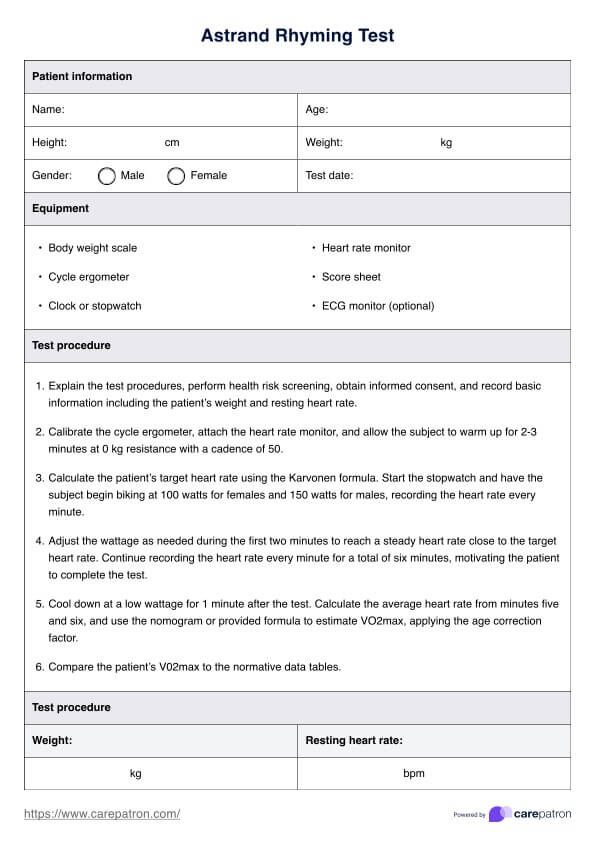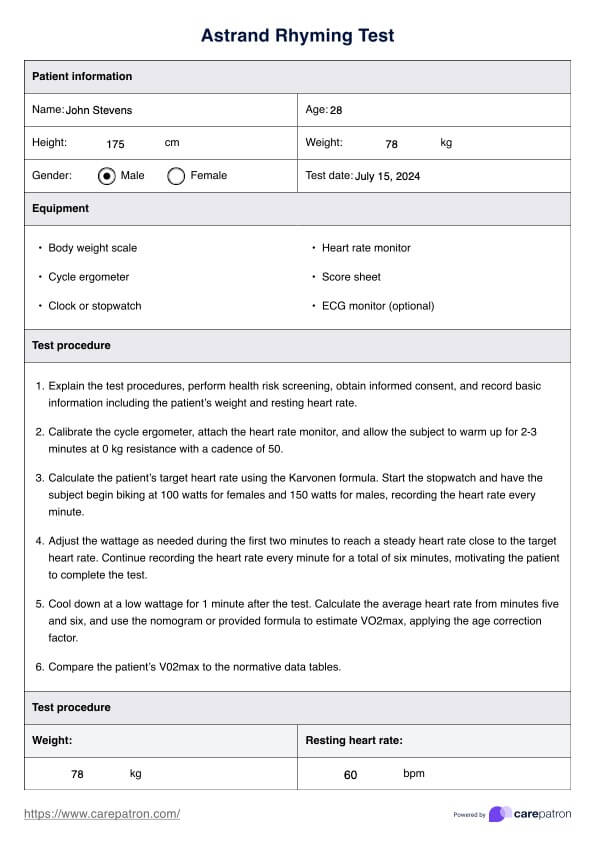Astrand Rhyming
Discover how to use the Astrand-Ryhming test to assess aerobic fitness with step-by-step instructions, benefits, and FAQs. Optimize patient care effectively!


What is the Astrand-Ryhming submaximal test?
The Astrand-Ryhming test is a submaximal cycle ergometer test used to estimate an individual’s maximal aerobic capacity and fitness, specifically their VO2max, which is the maximum amount of oxygen the body can utilize during intense exercise. Developed by Per-Olof Åstrand and Ivar Ryhming in the 1950s, this test, also known as the Astrand-Rhyming cycle ergometer test, measures the heart rate response to a fixed workload over six minutes, allowing for an estimation of aerobic capacity based on heart rate and workload. The test is often misspelled as "Astrand-Rhyming".
The test is typically used for patients who need to assess and determine their cardiovascular fitness without undergoing maximal exercise tests. It is suitable for various populations, including athletes, individuals undergoing rehabilitation, and those beginning an exercise program. The test is particularly beneficial for individuals who cannot perform maximal effort tests due to health conditions, as it provides a safe and efficient way to gauge aerobic fitness. Additionally, the Astrand-Ryhming cycle ergometer test effectively estimates maximal oxygen intake, providing a reliable prediction of VO2max in healthy and physically active college students.
Advantages and disadvantages
The Astrand-Ryhming test offers several advantages, making it a popular choice among healthcare professionals for assessing aerobic fitness. One of its primary advantages as an aerobic fitness test is its simplicity and ease of administration. The test requires minimal equipment—a cycle ergometer, heart rate monitor, stopwatch, and body weight scale—and can be completed quickly. Additionally, the submaximal nature of the test makes it safer for individuals who may not be able to perform maximal effort exercises, such as those with certain health conditions or those new to exercise programs. A lower steady-state heart rate during the test indicates the better your fitness.
However, the test also has some disadvantages. The accuracy of the VO2max estimation can be influenced by individual variability in maximum heart rate, leading to potential underestimation or overestimation of fitness levels. Environmental factors, such as room temperature and the patient’s emotional state, can also affect heart rate and, thus, the test results. Additionally, the test may favor cyclists or those accustomed to cycling, potentially skewing results for non-cyclists.
Astrand Rhyming Template
Astrand Rhyming Example
How to use our Astrand-Ryhming test template
The Astrand-Ryhming test is an effective method for healthcare professionals to assess the aerobic fitness of their patients through submaximal cycling. This template provides a structured approach to administering the Astrand-Ryhming test and recording the results. Follow these steps to utilize the template efficiently.
Step 1: Download the template
Start by downloading the Astrand Rhyming test template from our resources. Then, ensure you have all the necessary equipment, including a cycle ergometer, heart rate monitor, stopwatch, and body weight scale.
Step 2: Prepare the patient
Explain the test procedures to the patient, perform a health risk screening, and obtain informed consent. Record basic information such as the patient's age, height, weight, and resting heart rate. If possible, ensure the patient has recorded their resting heart rate upon waking up.
Step 3: Set up the cycle ergometer
Calibrate the cycle ergometer and attach the heart rate monitor to the patient. Allow the patient to warm up on the cycle ergometer for 2-3 minutes at a resistance of 0 kg with a cadence of 50.
Step 4: Conduct the test
Calculate the patient’s target heart rate using the Karvonen formula. Then, have the patient begin biking at 100 watts for females and 150 watts for males, adjusting the wattage during the first two minutes to reach a steady heart rate close to the target work rate. Record the heart rate every minute for a total of six minutes.
Step 5: Record and analyze the results
After the test, cool down at a low wattage for 1 minute. Calculate the average heart rate from minutes five and six. Use the provided formula or nomogram to estimate the VO2max and apply the age correction factor from the table. Adjusting VO2max calculations for different age groups is essential to ensure accuracy. Record all results in the template and discuss them with the patient.
Results, interpretation, and next steps of the Astrand bike test for aerobic capacity
The results of the Astrand bike test are determined by measuring the patient’s heart rate response to a submaximal exercise workload. Maximal oxygen uptake (VO2max) is a crucial measurement of aerobic fitness, estimated from the average heart rate during the final minutes of the six-minute cycling session using a nomogram or specific formula. The VO2max value, adjusted for age using the correction factor, indicates the patient’s aerobic fitness level.
Interpreting the results involves comparing the estimated VO2max to normative data for the patient’s age and gender. A higher VO2max indicates better aerobic capacity and cardiovascular health. Based on the results, healthcare professionals can recommend personalized exercise programs, monitor fitness progress, and identify potential cardiovascular issues. For patients with lower VO2max, a gradual and supervised exercise regimen can help improve their aerobic fitness. This correlation between VO2max and physical fitness underscores the importance of aerobic capacity as an indicator of overall physical fitness.
The next steps may include regular follow-up assessments to track improvements, modifications to the exercise plan based on progress, and additional tests if needed to gain a comprehensive understanding of the patient’s cardiovascular health.
Benefits of using our template
Using our Astrand-Ryhming test template simplifies the testing process and ensures accurate data collection. Here are three key benefits:
Standardization
Our template provides a consistent structure for conducting the Astrand-Ryhming test, ensuring that all necessary steps are followed and recorded accurately. This standardization minimizes errors and enhances the reliability of the astrand test results.
Efficiency
Healthcare professionals can save time setting up and administering the test using a pre-designed template. The template includes all essential fields and guidelines, making the process more streamlined and efficient.
Comprehensive documentation
The template ensures comprehensive documentation of patient data, test conditions, and results. This thorough record-keeping facilitates better analysis and follow-up, allowing for more effective patient progress and outcomes monitoring.
Commonly asked questions
It is a submaximal cycle ergometer test used to estimate aerobic fitness by measuring the heart rate response to a fixed workload over six minutes. It helps by predicting maximal oxygen intake based on submaximal performance.
The test is suitable for individuals looking to assess their cardiovascular fitness, including athletes training, patients in rehabilitation, and those beginning an exercise program.
VO2max is estimated using the patient's steady-state heart pulse rate during the test, workload, and age correction factor, often utilizing a nomogram or specific calculation formula.







































































































